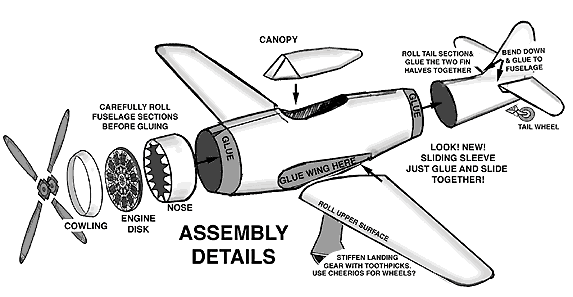
Grumman Bearcat - $$5.50
The Grumman F8F Bearcat (affectionately called "Bear") was an American single-engine naval fighter aircraft of the 1940s. It went on to serve into the mid-20th Century in the United States Navy and other air forces, and would be the company's final piston engined fighter aircraft.
Grumman F8F WWII Bearcat
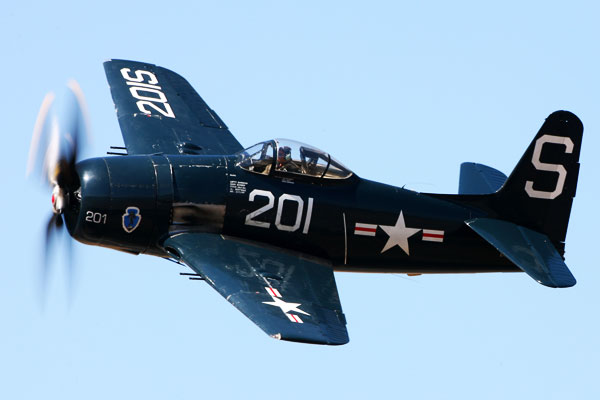
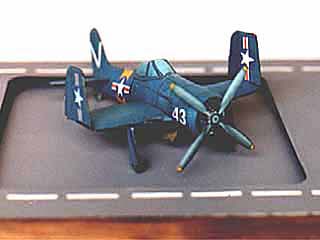
Most powerful and fastest of the 'cat' series but came into production at the end of WWII. It was an extremely high performance plane capable of taking off from the smallest carriers. Makes up into a sweetheart of a model.
The F8F was Grumman's last production in a line of piston-engine fighters which began with the FF-l when the company was set up in 1931. Grumman F8F Bearcat the company designated the project G-58 and development started in 1943.
I have re-colored two color schemes used by the Blues on their Bearcats, from 1946 to 1950. the first is the familiar blue and gold--the other the less so, "BeetleBomb" adversary aircraft that was used in the mock dogfight that was a highlight of the show back then. The Bearcat replaced the SNJ late in it's career, as it was too slow to keep up with the Panthers! It flew as part of the show until 1950, when it crashed. Shortly thereafter--the team went to war, and when the shows started back up again--a TV2 was used by the announcer / advance person...Rob Carleen
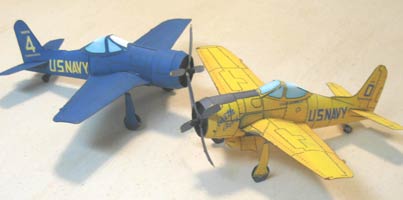
Wingspan six and 3/4 inches. Cockpit area on fuselage is covered with black paper. Two clear canopies are shown. I tried the suggested quick double packing tape method on the left one then played with gluing clear thin plastic onto the underside of a cut out frame. Both would work nicely. A cone was glued to the engine disk to help the prop clear the engine cowling. Prop assembly: The propeller blades are reinforced with straight wire. The large cardboard disc is glued inside the cowling, the smaller one is glued onto the propeller straight pin at the aft end of the brass tube. Finished model. The canopy frame was first painted with enamel then sanded after drying and finally touched up with acrylic paint....Bob Penikas
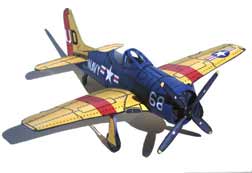
Hi guys!
I love this model, so I invested a little time into recoloring it. I darkened the paint scheme to what I think is the right color for all late-war Navy/Marine aircraft and used the historically accurate insignia for 1945/46 (what if the war went on longer?). I also added exhaust smudges and changed the canopy reflection.
I left numbers and letters and squadron markings off on purpose, I've found that multiple airplanes look funny when they all have the same numbers on them.
Feel free to include this in your Bearcat folder if you like it. If there is something wrong that you see please don't hesitate to let me know.
Thanks Ryan! I'm sure the guys will love this - Scott Fyn (added to folder June 26th 2014)
Included in this folder...
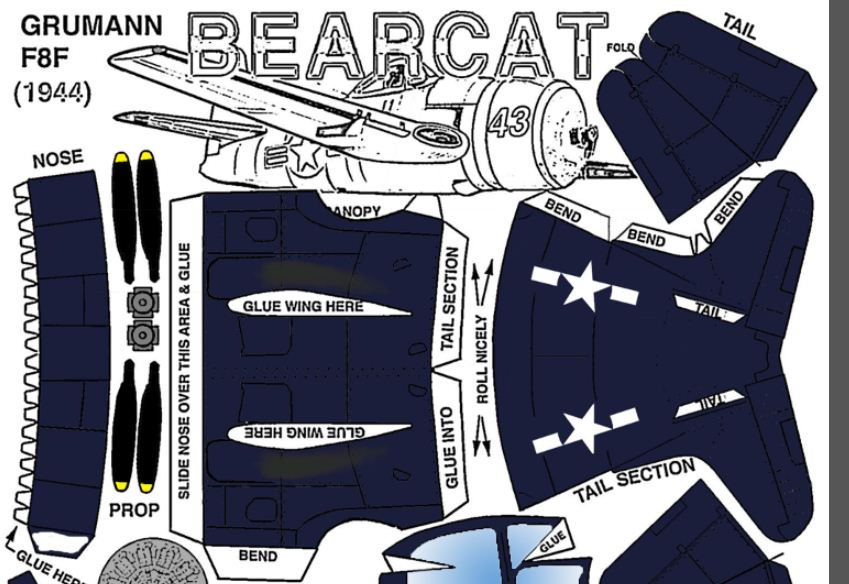
Grumman F8F Bearcat
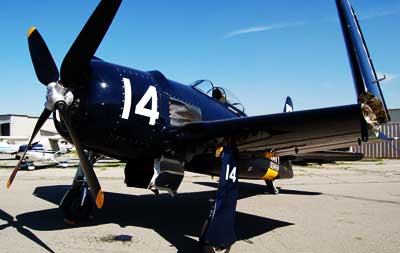 The F8F was Grumman's last production in a
line of piston-engine fighters which began with the FF-l when
the company was set up in 1931.
The F8F was Grumman's last production in a
line of piston-engine fighters which began with the FF-l when
the company was set up in 1931.
The company designated the project G-58 and development started in 1943. The requirement was for a high-performance aircraft capable of operation from even the smallest carrier. The G-58 was dimensionally smaller, but had a similar configuration to that of the F6F.
Grumman received an order from the US Navy on November 27, 1943, for two prototypes which were given the designation XF8F- 1. One of the initial design features, and a most unusual one, was the provision of break points in the wings, along with explosive bolts. The purpose of these was to overcome a potentially dangerous situation if the aircraft was handled too vigorously: the tips would fail at selected known points, but balance would hopefully be restored. However, this provision was abandoned at a later stage in the development program, though the wings folded only at the tips. Unlike the Hellcat, the landing gear of the Bearcat retracted inwards.
The engine chosen to power the Bearcat was the Pratt & Whitney R-2800 Double Wasp which had also powered the Hellcat. Unlike most new 'developments' the Bearcat was a smaller aircraft than the Hellcat and significantly lighter which gave it an outstanding power-to-weight ratio.
The Bearcat's range was average at 1105 miles, but its excellent climb capability of 4570ft/min more than made up for this. The first of the two prototypes made its maiden flight on August 21, 1944, with an R-2800-22W engine. It was an excellent first flight. The aircraft proved its high performance capability with a 4800 ft/min rate-of-climb and a maximum speed of 424 mph.
Armament consisted of four 12.7-mm (0.5-in) machine-guns, mounted in the wings, and two 1000-lb bombs or four 12.7-cm (5-in) rockets could be carried on inner-wing racks, or two drop tanks.
The navy came up with a production contract
on October 6, 1944. Grumman was to supply 2023 F8F-1 aircraft.
A few months later, on February 5, 1945, Eastern Aircraft (General
Motors) was contracted to produce 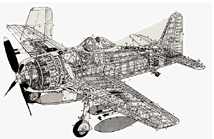 1876 Bearcats with the designation
F3M-1. Grumman started deliveries in February 1945, and the aircraft
were assigned to US Navy Squadron VF-19 which began to equip in
May of that year.
1876 Bearcats with the designation
F3M-1. Grumman started deliveries in February 1945, and the aircraft
were assigned to US Navy Squadron VF-19 which began to equip in
May of that year.
World War II ended without the Bearcat having seen operational service. The navy reduced its contracts to 770 aircraft but added an order for 126 F8F-1B Bearcats, with four 20-mm (0.79-in) cannon. Of the original order, 15 aircraft were revised as night fighters, with the designation F8F2N, with APS-6 radar. Navy squadrons continued to re-equip with the Bearcat and by 1948, the type was in service with 24 units.
Another version, the F8F-2, appeared in 1948 armed with 20-mm (0.79-mm) cannon. There were 293 of these built, as well as 12 night fighters, designated F8F-2N. Other changes included a taller fin and rudder, and the engine cowling was revised. Grumman also produced 60 F8F-2P photographic aircraft.
Production ended in May 1949. At this time, 12 navy squadrons operated the F8F-l and 12 the F8F-2. By the end of 1952, the type was completely out of service.
The Bearcat's operational life with the US Navy was relatively short, but surplus aircraft were sold to the French Arm& de l'Air and the Royal Thai Air Force, and the Bearcat gave an excellent account of itself in the Indo-Chinese war, fought between France and the communist Viet-Minh.
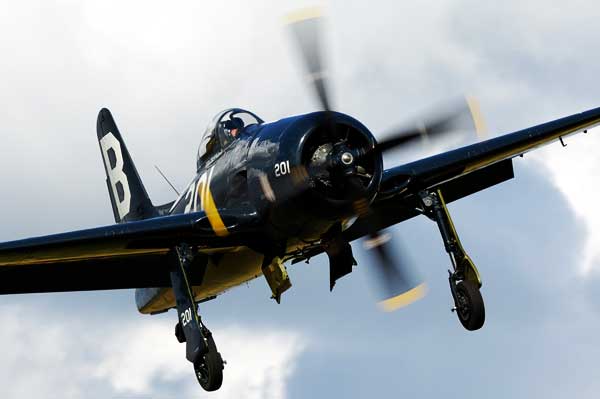
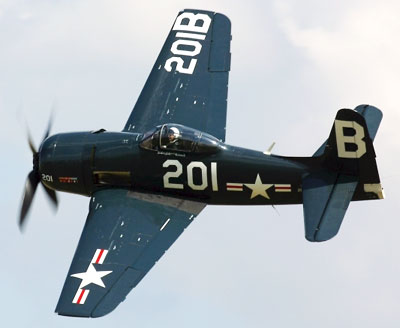 While Grumman's Hellcat was wresting air superiority from the
Japanese at high altitudes, its low-level performance was still
somewhat behind that of the lighter Japanese types. To fill this
gap in Navy fighter ranks, Grumman undertook the design of a scrappy,
light-weight fighter that would combine nimble maneuverability
with rapid climb characteristics. The Navy expressed its interest
in the project by awarding a development contract for two XF8F-1's
on November 27, 1943. Their faith in Grumman's engineering capabilities
is reflected in the fact that no full-scale mock-up was required-just
the engine mounting and a detailed cockpit. Grumman set about
their task with such rapidity that the Bearcat was in the air
on August 21, 1944-just ten months after the contract was approved.
While Grumman's Hellcat was wresting air superiority from the
Japanese at high altitudes, its low-level performance was still
somewhat behind that of the lighter Japanese types. To fill this
gap in Navy fighter ranks, Grumman undertook the design of a scrappy,
light-weight fighter that would combine nimble maneuverability
with rapid climb characteristics. The Navy expressed its interest
in the project by awarding a development contract for two XF8F-1's
on November 27, 1943. Their faith in Grumman's engineering capabilities
is reflected in the fact that no full-scale mock-up was required-just
the engine mounting and a detailed cockpit. Grumman set about
their task with such rapidity that the Bearcat was in the air
on August 21, 1944-just ten months after the contract was approved.
The Bearcat made an immediate hit with the pilots and required only moderate revisions to become fully acceptable to the K Navy. The second prototype, delivered in November, already embodied many of the changes. Most notable amwing these was the addition of a dorsal fin to improve its directional stability. Within five months of 1he XF8F-1's initial flight, the first production Bearcats were rolling out of the Grumman plant. Though a few of these planes had reached the Navy before the war had ended, none were used in combat.
The original contract called for 23 Bearcats, but this was upped to 2,023 before the first one was completed. This was followed by another increase of 4,000 planes. General Motors received a contract for 1,876 F2M-1 and F3M-1 Bearcats, but these became victims of the postwar cutback and none were built. Grumman also suffered a severe reduction in orders on VJ Day, with the result that only 765 of the FSF- 1 Bearcats were completed.
Grumman engineers included a novel feature into the design of the Bearcat's wings. In the event of excessively high "G" loads during maneuvering, the wingtips would break away to allow the shortened wings to safely withstand a higher "G" factor. The folding portion of the wing was designed to fail at half the distance to the tip if the plane exceeded 9 'G's." Problems with this system led to the addition of explosive bolts along the separation line, If only one tip separated, the explosive bolts would assure that the opposite side was ejected also. This would allow half of the aileron area to remain, but greatly reduced the stress on the balance of the wing structure permitting it to withstand even higher forces.
After the war, Bearcat production continued with the FSF-LB.
One hundred of these appeared with four 20 mm cannons replacing
the original Bearcat armament of four .50 cal. machine guns. Thirty-six
F8F-2's, with radar pods suspended from a pylon on the right wing,
were ordered as night fighters. Upgrading the design and increasing
the height of the tail brought about the F8F-2 and an order for
293 copies. The order also included 60 camera bearing F8F-2P's
with only two 20mm cannons.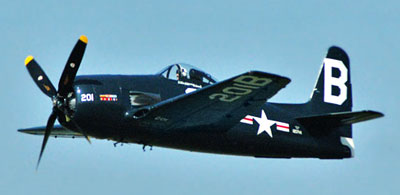
The Bearcat did not see combat in the colors of the U.S. Navy; but many of the planes, declared obsolete by the U.S. government, were delivered to the French for use in Indochina. These were in use by the Thais and Vietnamese during the conflict in that area.
Power for the nimble F8F came from a Pratt & Whitney R-2800-34W. With 2,100 hp for take off and 1,850 hp for maneuvering, the Bearcat had a maximum speed of 447 mph in the -2 version-26 mph faster than the first model. The FSF-1 had a wingspan of 35 feet 10 inches with an area of 244 square feet. It was 28 feet 3 inches long and stood 13 feet 10 inches high. By comparison, the FSF-2 was 27 feet 8 inches long and 12 feet 2 inches high.
Respective weights of the two were: FSF1-empty, 7,070 pounds; gross, 9,386 pounds; maximum, 12,947 pounds. F8F2-empty, 7,690 pounds; gross, 10,426 pounds; maximum, 13,494 pounds. Fuel capacities were 183 gallons for the -1 and 185 for the -2. The earlier model had a service ceiling of 38,700 feet and a range of 1,105 miles, compared to a 40,700 foot ceiling and 865 mile range for the -2. The rate of climb was rather exciting at some 4,500 fpm for the Bearcat.
Had the war continued, there is little doubt that the Bearcat would have been recorded as one of the combat greats along with its larger relative, the Hellcat, and the Vought Corsair. Fortunately, these latter two went a long way to eliminate the need for their nimble successor.
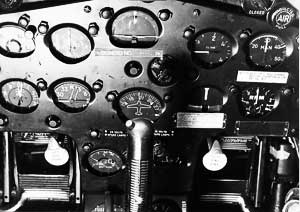 |
Grumman F8F Bearcat Cockpit. |
Specifications for the Grumman F8F Bearcat
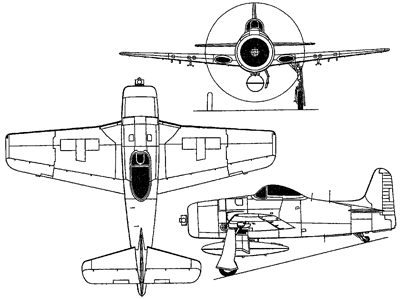 |
Length: 28 ft 3 in |
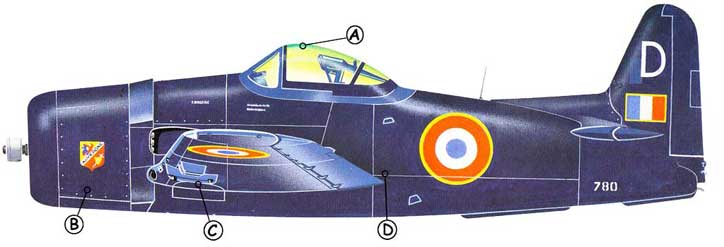 |
|||
| A: The high bubble canopy offered a superb view. The F8F had reduced cockpit armor compared to the F6F. | B: Powerful and reliable, the massive Double Wasp radial was an 18-cylinder air-cooled engine. | C: Armament consisted of four .50-cal, two in each wing. Four 5 in unguided rockets, and 1,000 lb bombs. | D: Grumman were famous for their strong airframes and the Bearcat was no exception. The large main fuel tank 180 gallons was under the cockpit. |
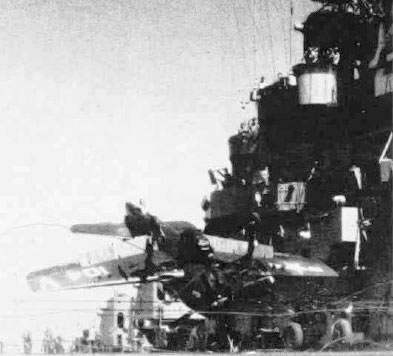 |
Barrier crash of a U.S. Navy Grumman F8F-1 Bearcat from fighter squadron VF-11A Sundowners, on the aircraft carrier USS Valley Forge (CV-45) during that carrier's world cruise between October 1947 and June 1948. |



